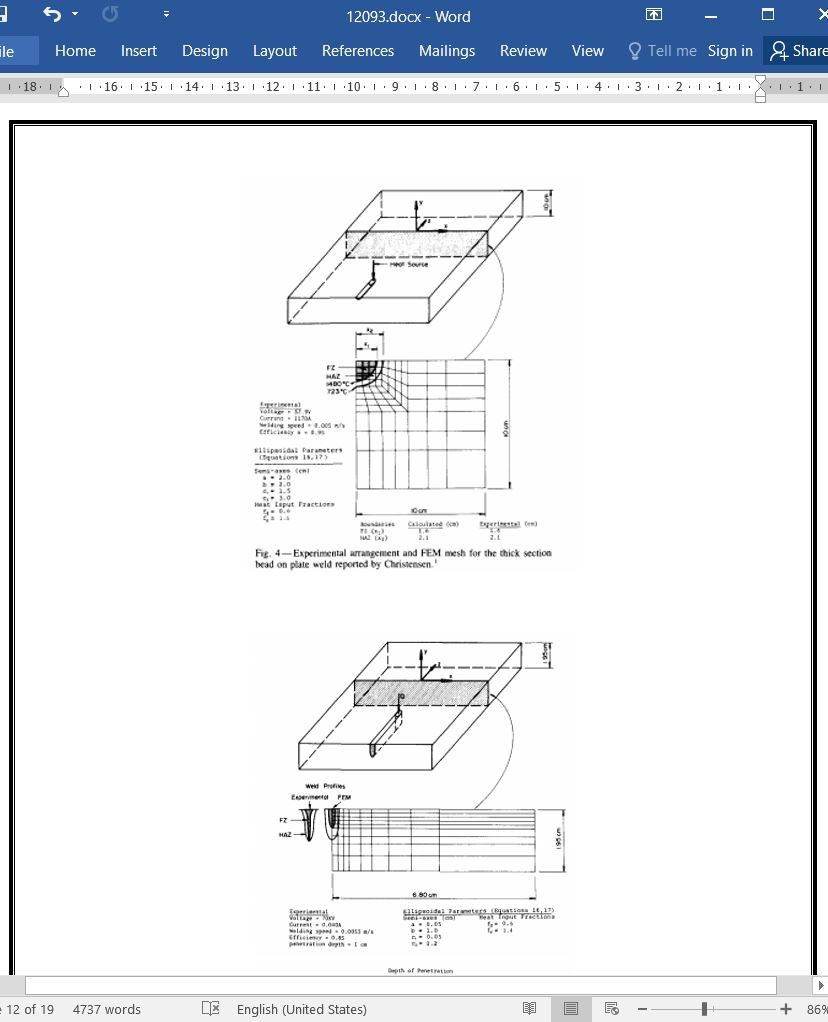
یک مدل جدید المان محدود برای منابع حرارتی جوشکاری
یک مدل ریاضی برای منابع حرارتی جوش بر مبنای توزیع گاوسی چگالی توان در فضا ارائه شده است. به خصوص، هندسه بیضوی دوگانه ای ارائه شده است، به طوری که اندازه و شکل منبع گرما را می توان به راحتی برای مدلسازی هر دو فرایند جوشکاری قوس نفوذ کم عمق و لیزر نفوذ عمیقتر و فرآیندهای شعاع الکترونی تغییر داد. علاوه بر این، این مدل دارای تطبیق پذیری و انعطاف پذیری برای اداره موارد غیر متقارن محوری مانند الکترودهای نوار یا اتصال فلزات ناهمسان می باشد. مدلهای قبلی، تقارن دایره ای یا کروی را در نظر گرفته اند. محاسبات به وسیله ASGARD ، که یک برنامه طراحی شده برای جریان گرمایی المان محدود گذرای غیرخطی (FEM) برای تحلیل تنش حرارتی جوش است انجام می شود.* توزیع درجه حرارت محاسبه شده برای جوش های قوس غوطه ور در قطعات ضخیم ، با مقادیر اندازه گیری شده که توسط Christensen 1گزارش شد و مقادیر محاسبه شده FEM( مدل منبع حرارت سطحی) Krutz و Segerlind مورد مقایسه قرار گرفته است. 2علاوه بر این، سابقه حرارتی محاسبه شده از جوش شعاع الکترونی نفوذ عمیق با مقادیر اندازه گیری شدۀ Chong ، مقایسه شده است. مطابقت مقادیر محاسبه شده و مقادیر اندازه گیری شده بسیار عالی نشان داده شده است.
1. مقدمه
مسائل مربوط به اعوجاج، تنش پسماند، و کاهش مقاومت یک سازه در داخل و اطراف یک اتصال جوش، از نگرانیهای مهم در صنعت جوشکاری هستند. این مسائل مستقیما از سیکل حرارتی ناشی از ورودی حرارت شدید موضعی از جوشکاری ذوبی بوجود می آیند. درجه حرارت بالای ایجاد شده توسط منبع حرارت، موجب تغییرات متالورژیکی شدیدی در اطراف منطقه جوش فولاد ساختمانی کم کربن می شود. سابقه حرارتی، به ویژه زمان خیساندن در دماهای بالا و زمان خنک شدن از 800 تا 500 ریزساختار و ویژگیهای مکانیکی را برای یک ترکیب خاص تعیین می کند. زمان خنک شدن از 400 تا 150 ، عامل کنترل کننده ای در انتشار هیدروژن و ترک خوردگی سرد جوشها است. پیش بینیهای دقیق تنش پسماند، اعوجاج، و مقاومت سازۀ جوش داده شده، مستلزم تجزیه و تحلیل دقیق سیکل حرارتی است. اهمیت یک مدل خوب برای منبع حرارتی جوش در تحلیل سیکل حرارتی، توسط چند تن از محققان مورد تاکید قرار گرفته است. 12'4-9 پس از بررسی عملکرد چند مدل، یک مدل جدید منبع حرارتی جوش پیشنهاد شده است که نه تنها دقیق تر از مدلهایی است که در حال حاضر در دسترس هستند، بلکه اولین مدلی است که می تواند موارد فاقد تقارن شعاعی را کنترل کند. علاوه براین، این مدل بردار بار صافی دارد که موجب کاهش خطا و هزینه های محاسباتی تحلیل FEM می شود.
A mathematical model for weld heat sources based on a Gaussian distribution of power density in space is presented. In particular a double ellipsoidal geometry is proposed so that the size and shape of the heat source can be easily changed to model both the shallow penetration arc welding processes and the deeper penetration laser and electron beam processes. In addition, it has the versatility and flexibility to handle non-axisymmetric cases such as strip electrodes or dissimilar metal joining. Previous models assumed circular or spherical symmetry. The computations are performed with ASGARD, a nonlinear transient finite element (FEM) heat flow program developed for the thermal stress analysis of welds.* Computed temperature distributions for submerged arc welds in thick workpieces are compared to the measured values reported by Christensen1 and the FEM calculated values (surface heat source model) of Krutz and Segerlind.2 In addition the computed thermal history of deep penetration electron beam welds are compared to measured values reported by Chong.3 The agreement between the computed and measured values is shown to be excellent.
I. INTRODUCTION
THE problems of distortion, residual stresses, and reduced strength of a structure in and around a welded joint are a major concern of the welding industry. These problems result directly from the thermal cycle caused by the localized intense heat input of fusion welding. The high temperatures developed by the heat source cause significant metallurgical changes around the weld area of low carbon structural steels. The thermal history, particularly soaking time at high temperatures and cooling time from 800 to 500 C determines the microstructure and mechanical properties for a given composition. The cooling time from 400 to 150 C is a controlling factor in the diffusion of hydrogen and the cold cracking of welds. Accurate predictions of residual stress, distortion, and strength of welded structures require an accurate analysis of the thermal cycle. The importance of a good model for the weld heat source in the analysis of the thermal cycle has been emphasized by several investigators. 12'4-9
1. مقدمه
2. فرمول بندی نظری
A. ملاحظات مدل
B. توزیع شار سطح گاوسی
C. توزیع تراکم توان نیمکره
D. توزیع تراکم توان بیضوی
E. توزیع تراکم توان بیضوی دوگانه
محاسبات FEM
3. ارزیابی مدل بیضی دوگانه
A. تایید مدل
B. برآوردهای پارامترهای توزیع شار مشخصه
4. نتایج
A. تحلیل مسئله صفحات ضخیم
B. تحلیل جوش شعاع الکترونی
5. نتیجه گیری
منابع
I. INTRODUCTION
II. THEORETICAL FORMULATIONS
A. Model Considerations
B. Gaussian Surface Flux Distribution
C. Hemispherical Power Density Distribution
D. Ellipsoidal Power Density Distribution
E. Double Ellipsoidal Power Density Distribution
FEM CALCULATIONS
III. EVALUATION OF THE DOUBLE ELLIPSOID MODEL
A. Verification of the Model
B. Estimates of Characteristic Flux Distribution Parameters
IV. RESULTS
A. Analysis of the Thick Plate Problem
B. Analysis of the Electron Beam Weld
V. CONCLUSIONS
REFERENCES
- ترجمه فارسی مقاله با فرمت ورد (word) با قابلیت ویرایش، بدون آرم سایت ای ترجمه
- ترجمه فارسی مقاله با فرمت pdf، بدون آرم سایت ای ترجمه



